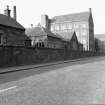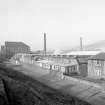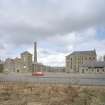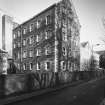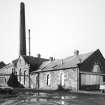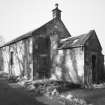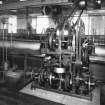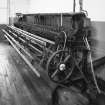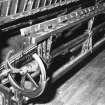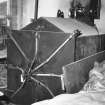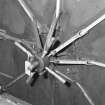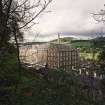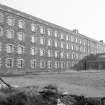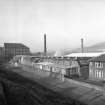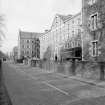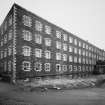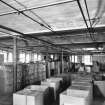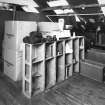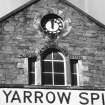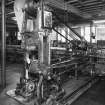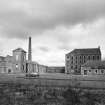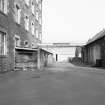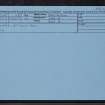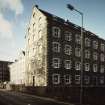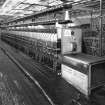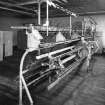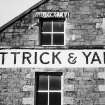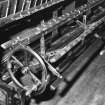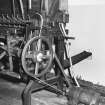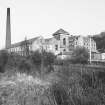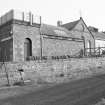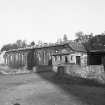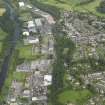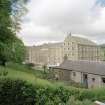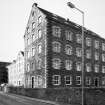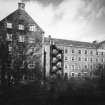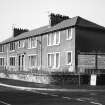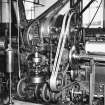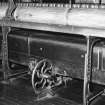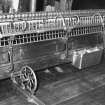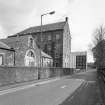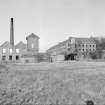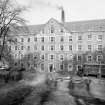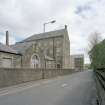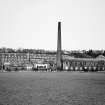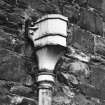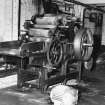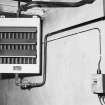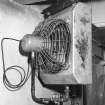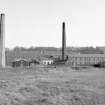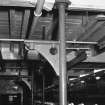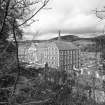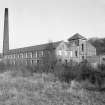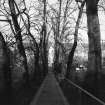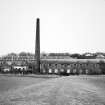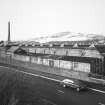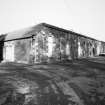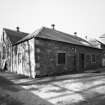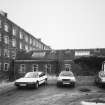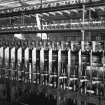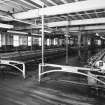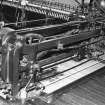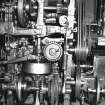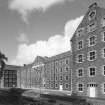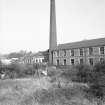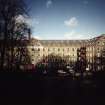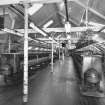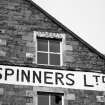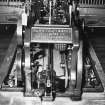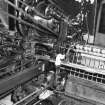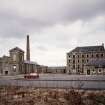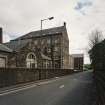Selkirk, Dunsdale Road, Ettrick Mill
Spinning Mill (19th Century), Woollen Mill (19th Century)
Site Name Selkirk, Dunsdale Road, Ettrick Mill
Classification Spinning Mill (19th Century), Woollen Mill (19th Century)
Alternative Name(s) Ettrick And Yarrow Spinners; Messrs James And Henry Brown; Scottish Co-operative Society; Dk Colledge
Canmore ID 54246
Site Number NT42NE 48
NGR NT 47168 29288
NGR Description Centred NT 47168 29288
Datum OSGB36 - NGR
Permalink http://canmore.org.uk/site/54246
- Council Scottish Borders, The
- Parish Selkirk
- Former Region Borders
- Former District Ettrick And Lauderdale
- Former County Selkirkshire
NT42NE 48 centred 47168 29288
In 1819 James and Henry Brown, sons of William Henry (the 'Baron'), started business, on their own account in Galashiels. In 1835 they moved to Selkirk where they erected the original portion of Ettrick Mill. In recognition of the benefit they had conferred on the burgh of Selkirk, brothers James and Henry were presented with the freedom of the burgh of Selkirk.
Information taken from Hall, 1898.
Messrs J and H Brown were the first in Selkirk to introduce the new and improved condensers.
D Bremner 1969.
Dating from 1836 and 1850, Ettrick Mill is the most imposing factory building in Selkirk. The symmetrical range has a central gabled pediment, with palladian windows and a clock. The supporting blocks are completed with projecting gabled wings.
Information from J Butt, 1969.
(Location cited as NT 473 293). Ettrick Mill: built 1836-50 (main block) and later. A large group with two principal blocks and weaving sheds.
The older and finer of the main buildings is a 5-storey, 27-bay structure, with 8-bay wings at each end. The central three bays of the frontage are gables, the middle bay having Palladian windows.
The other [building] is a 4- by 11-bay building with a projecting machicolated tower.
The single-storey engine house has a cast-iron roof tank, and the boiler house is served by a tall octagonal brick chimney.
There are interesting 8-, 4- and 8-bay blocks of weaving sheds, with the gable walls extended almost to the apex of the gables.
J R Hume 1976.
The origins of Ettrick Mill can be attributed to the firm of Messrs. James and Henry Brown, who in 1835, started their operations. The mill was subsequently doubled in 1850. Following the death of Mr James Brown in 1852, his sons in 1859 returned to Galashiels where they established a prosperous mill at Buckhom Mill (NT43NE 72). Mr Henry Brown continued on at Ettrick mill. Following his death in 1860, the firm was carried on by his sons until 1883. The firm was awarded a medal at the first Great Exhibition of 1851 and also in various other exhibitions in Europe, America and India.
Motive power came from 3 water wheels, which were supplemented by powerful steam engines capable of working up to 400 hp.
In 1901 the Scottish Co-operative Society became the new owners and used their new capital investment to supply their own needs.
The mill was later rented to DK Colledge of Yarrow Mill in 1949. Working on a commission basis, they produced spun carpet yarns for a west of Scotland manufacturer right up until 1960, when Colledge purchased the mill. Colledge died in 1962. In March 1972 his sons William and James took over the running of the yarn spinning business. In 1980 the work of Ettrick and Yarrow Spinners was transferred to Ettrick Mill where it continued until 1998, when it was forced to close.
Information taken from 'The Little Guide to Selkirk Mills', c. 2000.
During March 1999, RCAHMS in order to enhance and augment the holdings of the National Monuments Record conducted a photographic survey of Ettrick Mill. At the time of this survey Ettrick Mill was largely disused and standing empty.
Visited by RCAHMS (MKO), March 1999.
Ettrick Mill, since 1997, has been in the hands of the Galashiels based Scottish Border Enterprise Council. They have made the main handsome structure both wind and water tight. They are now, during winter 2000/2001, in the process of finding likely tenants to occupy portions of the mill. There have also been suggestions/rumours that the Scottish Border Council Library Headquarters may occupy a portion of this mill.
Information from RCAHMS (DHR), January 2001.
Shed to North-East of main mill, circa 1880-90, excluding large modern extension. 2 blocks of North-lit sheds, later united by sheet-metal-clad shed which now appears to be demolished. High parapet walls, with round-arched windows and doors to Southern-most 8 bay block (perhaps for wool scouring, given the louvred ventilator). North block (perhaps weaving shed') blind 12-bay, 8 bays set back behind later lean-to additions. Small building in re-entrant perhaps an engine house. Slate roofs with North-East-facing skylights.
Part of the biggest mutli-storey spinning mill in the Borders. Built for mule-spinning by James and Henry Brown of Galashiels, honorary burgesses of Selkirk. Later carried on by the Scotch Tweed Manufacturing Society and from 1895 was the Ettrick Tweed and Blanket Mill of the Scottish Wholesale Cooperative Society, converted solely to spinning by Ettrick and Yarrow Spinners Ltd FROM 1962. Spinning ceased in the multi-storey mill in 1989, but continues in the modern shed (built 1968, not of special architectural interest). Some machinery is now displayed and worked at New Lanark. (Historic Environment Scotland List Entry)
Standing Building Recording (March 2017)
NT 47168 29288 A basic photographic survey, March 2017, recorded the current layout of Ettrick Mill’s fourth floor and attic space prior to its conversion into modern offices. The configuration of the column layout and spacing within all four units was directed by the spinning machinery being
used. Only a single late 20th-century motor-driven spinning machine has survived in situ within the West Range. Earlier 19th-century power transmission would have been through the use of line-shafts and belt drives running the length of each floor. The bracketed columns confirm the route of a central line shaft probably driving three rows of spinning mules.
The survey results confirm that only two attics survive. All the lath-and-plaster fireproof linings within all four units (with the exception of a fragment observed) has been removed to allow roof repairs to be undertaken sometime during the last 20 years.
Archive: NRHE (intended). Reports: Scottish Borders HER and NRHE
Funder: Scottish Enterprise
Michael Cressey – CFA Archaeology Ltd
(Source: DES, Volume 18)
Sbc Note
Visibility: This is an upstanding building.
Information from Scottish Borders Council.
Standing Building Recording
A basic photographic survey recorded the current layout of
Ettrick Mill's fourth floor and attic space prior to its
conversion into modern offices.
The configuration of the column layout and spacing within all
four units was directed by the spinning machinery being used.
Only a single late 20th century motor-driven spinning
machine has survived in situ within the West Range. Earlier
19th century power transmission would have been through the
use of line-shafts and belt drives running the length of each
floor. The bracketed columns confirm the route of a central
line shaft probably driving three rows of spinning mules.
The survey results confirm that only two attics survive. All the
lath-and-plaster fireproof linings within all four units (with the
exception of a fragment observed) has been removed to allow
roof repairs to be undertaken (replacement roof lights and
rafter strengthening) some time during the last 20 years.
Source: CFA Archaeology Ltd (MJ) to SBC HER
Funder: Scottish Enterprise




























































































